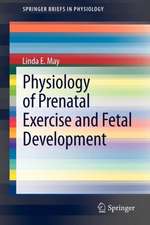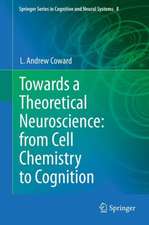Cell Death: Mechanism and Disease
Editat de Hao Wuen Limba Engleză Hardback – 14 noi 2013
Physiological cell death plays critical roles in almost all aspects of biology, and the book details its roles in lymphocyte homeostasis, neuronal function, metabolism, and the DNA damage response. When physiological cell death goes awry, diseases can arise, and cancer is presented as a central paradigm for the consequences of derangements in the interplay between cell survival and cell death. At the same time, the potential promise of targeted therapies aimed at interdicting cell death machineries are also discussed extensively. The molecular mechanisms that underlie apoptotic cell death are illustrated from the perspectives of both the intrinsic, mitochondrial apoptotic pathway and the extrinsic, death receptor pathway. Key players in these pathways, such as the Bcl2 family proteins, cytochrome c, Apaf-1, caspases, death receptor adapter proteins, and inhibitor of apoptosis proteins, are presented from both functional and structural angles. Until only a few years ago, programmed cell death has been considered essentially synonymous with apoptosis. However, we now know that programmed cell death can also take other forms such as necrosis or necroptosis, and to this end, the mechanisms that underlie programmed necrosis in development and host defense are illustrated. The past twenty plus years have seen an incredible growth of research in cell death, with one breakthrough after another, and the legacy still goes on with constant new surprises and findings. Long live cell death!
| Toate formatele și edițiile | Preț | Express |
|---|---|---|
| Paperback (1) | 944.06 lei 6-8 săpt. | |
| Springer – 23 aug 2016 | 944.06 lei 6-8 săpt. | |
| Hardback (1) | 649.87 lei 6-8 săpt. | |
| Springer – 14 noi 2013 | 649.87 lei 6-8 săpt. |
Preț: 649.87 lei
Preț vechi: 764.55 lei
-15% Nou
Puncte Express: 975
Preț estimativ în valută:
124.36€ • 129.05$ • 103.95£
124.36€ • 129.05$ • 103.95£
Carte tipărită la comandă
Livrare economică 15-29 martie
Preluare comenzi: 021 569.72.76
Specificații
ISBN-13: 9781461493013
ISBN-10: 1461493013
Pagini: 400
Ilustrații: XII, 272 p. 46 illus., 42 illus. in color.
Dimensiuni: 155 x 235 x 20 mm
Greutate: 0.68 kg
Ediția:2014
Editura: Springer
Colecția Springer
Locul publicării:New York, NY, United States
ISBN-10: 1461493013
Pagini: 400
Ilustrații: XII, 272 p. 46 illus., 42 illus. in color.
Dimensiuni: 155 x 235 x 20 mm
Greutate: 0.68 kg
Ediția:2014
Editura: Springer
Colecția Springer
Locul publicării:New York, NY, United States
Public țintă
ResearchCuprins
1. Historical Perspective – the Seven Ages of Cell Death Research.- 2. The Intrinsic Apoptotic Pathway.- 3. Molecular Basis of Cell Death Programs in Mature T Cell Homeostasis.- 4. Bcl-2 family and their therapeutic potential.- 5. IAP proteins and their therapeutic potential.- 6. Cell Death and Cancer.- 7. The DNA damage response mediates apoptosis and tumor suppression.- 8. Neuronal Death Mechanisms in Development and Disease.- 9. The Complex Interplay Between Metabolism and Apoptosis.- 10. Programmed Necrosis/Necroptosis: An Inflammatory Form of Cell Death.- 11. Structural Perspectives on BCL-2 Family of Proteins.- 12. Structural basis of death receptor signaling.
Recenzii
From the book reviews:
“This new book comprises reviews of primary studies that elucidate apoptotic pathways in specialized cells and suggest points of intervention for the treatment of various cancers. … Summing Up: Highly recommended. Upper-division undergraduates through professionals.” (S. K. Sommers Smith, Choice, Vol. 51 (11), August, 2014)
“This new book comprises reviews of primary studies that elucidate apoptotic pathways in specialized cells and suggest points of intervention for the treatment of various cancers. … Summing Up: Highly recommended. Upper-division undergraduates through professionals.” (S. K. Sommers Smith, Choice, Vol. 51 (11), August, 2014)
Notă biografică
Hao Wu, Ph.D., is the Asa and Patricia Springer Professor at Harvard Medical School where she is a member of the Department of Biological Chemistry and Molecular Pharmacology. She is also a Senior Investigator in the Program in Cellular and Molecular Medicine at Boston Children’s Hospital. Her research focuses on elucidating the molecular basis of signal transduction by immune receptors, including the induction of cell death pathways.
Textul de pe ultima copertă
Beginning from centuries of anecdotal descriptions of cell death, such as those on the development of the midwife toad in 1842 by Carl Vogt, to modern-day investigations of cell death as a biological discipline, it has become accepted that cell death in multicellular organisms is a normal part of life. This book provides a comprehensive view of cell death, from its mechanisms of initiation and execution, to its implication in human disease and therapy.
Physiological cell death plays critical roles in almost all aspects of biology, and the book details its roles in lymphocyte homeostasis, neuronal function, metabolism, and the DNA damage response. When physiological cell death goes awry, diseases can arise, and cancer is presented as a central paradigm for the consequences of derangements in the interplay between cell survival and cell death. At the same time, the potential promise of targeted therapies aimed at interdicting cell death machineries are also discussed extensively. The molecular mechanisms that underlie apoptotic cell death are illustrated from the perspectives of both the intrinsic, mitochondrial apoptotic pathway and the extrinsic, death receptor pathway. Key players in these pathways, such as the Bcl2 family proteins, cytochrome c, Apaf-1, caspases, death receptor adapter proteins, and inhibitor of apoptosis proteins, are presented from both functional and structural angles. Until only a few years ago, programmed cell death has been considered essentially synonymous with apoptosis. However, we now know that programmed cell death can also take other forms such as necrosis or necroptosis, and to this end, the mechanisms that underlie programmed necrosis in development and host defense are illustrated. The past twenty plus years have seen an incredible growth of research in cell death, with one breakthrough after another, and the legacy still goes on with constant new surprises and findings. Long live cell death!
Hao Wu,Ph.D., is the Asa and Patricia Springer Professor at Harvard Medical School where she is a member of the Department of Biological Chemistry and Molecular Pharmacology. She is also a Senior Investigator in the Program in Cellular and Molecular Medicine at Boston Children’s Hospital. Her research focuses on elucidating the molecular basis of signal transduction by immune
receptors, including the induction of cell death pathways.
Physiological cell death plays critical roles in almost all aspects of biology, and the book details its roles in lymphocyte homeostasis, neuronal function, metabolism, and the DNA damage response. When physiological cell death goes awry, diseases can arise, and cancer is presented as a central paradigm for the consequences of derangements in the interplay between cell survival and cell death. At the same time, the potential promise of targeted therapies aimed at interdicting cell death machineries are also discussed extensively. The molecular mechanisms that underlie apoptotic cell death are illustrated from the perspectives of both the intrinsic, mitochondrial apoptotic pathway and the extrinsic, death receptor pathway. Key players in these pathways, such as the Bcl2 family proteins, cytochrome c, Apaf-1, caspases, death receptor adapter proteins, and inhibitor of apoptosis proteins, are presented from both functional and structural angles. Until only a few years ago, programmed cell death has been considered essentially synonymous with apoptosis. However, we now know that programmed cell death can also take other forms such as necrosis or necroptosis, and to this end, the mechanisms that underlie programmed necrosis in development and host defense are illustrated. The past twenty plus years have seen an incredible growth of research in cell death, with one breakthrough after another, and the legacy still goes on with constant new surprises and findings. Long live cell death!
Hao Wu,Ph.D., is the Asa and Patricia Springer Professor at Harvard Medical School where she is a member of the Department of Biological Chemistry and Molecular Pharmacology. She is also a Senior Investigator in the Program in Cellular and Molecular Medicine at Boston Children’s Hospital. Her research focuses on elucidating the molecular basis of signal transduction by immune
receptors, including the induction of cell death pathways.
Caracteristici
Provides a comprehensive view of cell death Details the role of cell death in lymphocyte homeostasis, neuronal function, metabolism, and the DNA damage response Discusses the potential promise of targeted therapies aimed at interdicting cell death machineries











